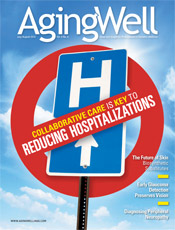
July/August 2012
BP Difference Between Arms Warrants InvestigationBy Kristin Rile A patient visiting a physician’s office has an expectation of what will occur in the course of the workup. Healthcare personnel will record height, weight, and blood pressure and note lifestyle changes and current medications. But there may be a missing component that can provide additional important patient information. According to a study conducted by a team led by Christopher Clark, FRCP, PhD, at the Peninsula College of Medicine and Dentistry in England, and recently published in The Lancet, physicians and their nursing staff should measure blood pressure in both arms rather than the current standard of only one arm. The latest research included 20 studies that examined differences in systolic blood pressure between an individual’s left and right arms. If there was a difference of at least 10 mm Hg in the systolic blood pressure readings between the two arms, it indicated the likelihood of a blocked artery. The results of the research indicated that a difference of 15 mm Hg or more was linked to an increased risk of peripheral vascular disease, or the narrowing arteries supplying the arms and legs, and the development of cardiovascular disease. The same study also found an increased risk of developing peripheral vascular disease, characterized by a difference of 10 mm Hg or higher. Researchers found that many patients who had developed peripheral vascular disease suffered reduced blood flow to the legs and feet. They also found that the risk of decreased blood flow to the brain was increased 1.6 times. According to the study authors, a significant difference in blood pressure was associated with a 70% increased risk of dying from cardiovascular disease and a 60% increased risk of death from any cause. Clark and his team noted that it didn’t matter which arm had the higher or lower blood pressure; it’s the difference that warrants further investigation. Critical Measure “This is an important [finding] for the general public and for primary care doctors,” says William O’Neill, MD, a professor of cardiology and executive dean of clinical affairs at the University of Miami Miller School of Medicine. “Traditionally, most people just check blood pressure in one arm, but if there is a difference, then one of the arteries has disease in it.” Particularly in smokers and diabetics, he notes, arteries may be blocked. “If one artery is more blocked than the other, then there is a difference in blood pressure in the arms,” O’Neill says. “Doctors should, for adults—especially adult smokers and diabetics—at some point check the blood pressure in both arms. If there is a difference, it should be looked into further.” “Men and women with differing blood pressure levels are more than twice as likely to have peripheral vascular disease,” says Gregg Fonarow, MD, FACC, FAHA, a professor of cardiology at UCLA and a spokesperson for the American Heart Association. Peripheral vascular disease is the hardening or narrowing of the arteries that supply the arms and legs with blood. “[These patients] are nearly twice as likely to have cerebrovascular disease, which affects blood flow to the brain and can contribute to stroke. Individuals whose blood pressure varied between their arms also had an increased risk for dying from a cardiovascular problem.” Nurses who take patients’ vitals sometimes choose the arm that is more convenient to take a patient’s blood pressure while other times they may ask a patient which arm he or she prefers. “I recently took [my employer] to the doctor’s office, and the nurse asked her which arm she would rather have her blood pressure taken with,” says Melissa Kleva, a caregiver for an older woman in Ocean City, New Jersey. This type of medical procedure has become common in most hospitals and private practices, but according to Fonarow, this type of practice can potentially have a negative impact on a patient’s overall health. Although the American Heart Association recommends that doctors and nurses measure blood pressure in both arms for every patient during each visit, there are some patients who are at a higher risk of adverse health events than others due to lifestyle behaviors. “Older adults, individuals who are smokers, those with diabetes, and those with hypertension are particularly at risk for having a blood pressure difference between their two arms,” Fonarow says. He notes that individuals who are overweight or obese, those with high cholesterol, and those who do not engage in regular exercise are also at increased risk. Following Up Peripheral vascular disease shows no physical symptoms, so without testing for a significant difference in blood pressure between a patient’s arms, this silent killer may go unnoticed for years. “Early detection allows one to take steps aimed at lessening the likelihood of heart attacks, stroke, and premature cardiovascular death. These steps include stopping smoking or medications to normalize blood pressure or lower bad cholesterol levels,” Fonarow says. Peripheral vascular disease is preventable and treatable with the proper knowledge and steps to a more healthful lifestyle. Regular exercise; annual checkups, including blood pressure readings taken in both arms; living a smoke-free lifestyle; and keeping a conscious eye on cholesterol levels can significantly decrease the risk of developing peripheral vascular disease as well as cardiovascular disease. In addition to the American Heart Association, the World Health Organization, the International Society of Hypertension Guidelines, and the European Society of Hypertension all recommend measuring blood pressure in both arms at a patient’s initial assessment. — Kristin Rile is an editorial intern at Great Valley Publishing Company. |
![]()
